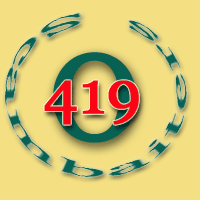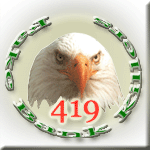
• Home •
Victim´s Story •
Fraud Prevention •
Project GSO •
Hall of Shame •
LINKS •

Tips for Victims of Check Fraud
The Check Fraud Battle
So Many Weapons, So Little Time
Computer and printer technology innovations have made life so much easier for everyone. Word processing, spreadsheets, e-mail, on-line banking and many other activities have made the workplace more efficient and productive.
But these same technology innovations have been the main contributors to a significant increase in losses due to check fraud. With a home computer and a laser printer, anyone can create authentic-looking checks that only require your company's account number to make them look and act as if they were real. And with the proper inside knowledge, an emloyee may be able to "print off a few checks" rather easily.
Due to the fact that new federal regulations now allow banking institutions to share check fraud liability with their customers, fighting check fraud becomes everyone's responsibility. Fortunately, the same technology that has made check fraud so much easier has paved the way for even better technologies for fraud prevention.
Good news, right? Well, maybe.
These technologies have been developed along several different fronts; writing checks that are more secure (check writing software, laser printng on blank check stock), writing fewer checks (online banking, EFT, ACH, payroll services), and protecting the checks once they are issued (positive pay, reverse positive pay, image positive pay. thumbprint verification). If you could assemble all of these technologies into one package, you could prevent nearly all check fraud affecting your company. The problem is, for a single company to incorporate all of these fraud prevention strategies it would be cost-prohibitive and too time-consuming to handle the workload.
What your company needs to do is determine where the greatest risk exists, and then develop a strategy that incorporates the most effective fraud prevention weapons for your company's specific needs.
Here is a current list of the most popular fraud prevention technologies available and some of the advantages and disadvantages to incorporating such a strategy.
Positive Pay
Positive pay (along with EFT) is turning out to be the most effective weapon against check fraud. The process is quite simple: A company issues checks. They then transmit an electronic file to the bank that contains a record of all checks currently issued. The bank will only pay those checks included in the file that match all of the issue criteria (check number, date, amount and sometimes payee). Many banks will then send an exception list to the customer that contains checks waiting to pay that were not in any positive pay file. This gives the customer the opportunity to pay, not pay or hold the exception check(s).
Positive pay prevents fraud from altered checks, checks printed elsewhere, checks from stolen check stock and even valid issued checks that are lost or stolen. Most banks offer positive pay - some charge for the service and some do not. Several companies (including AcuPrint) offer positive pay software that facilitates creation and transmission of the positive pay file and enables companies of any size to use positive pay.
Positive pay also inhibits internal fraud in that it adds additional levels of security that reduce each employee's role in the check writing process
Reverse Positive Pay
Reverse positive pay is exactly the same as positive pay, only opposite! Reverse positive pay requires that when the bank is ready to pay checks received on a given day, they first need the customers' approvals. They transmit a file to the customer that contains a list of all the checks waiting to pay. The customer can label the check pay, don't pay or hold. The file is then returned to the bank.
Many banks offer this service on-line making it fairly easy to use. But if a company writes even an average amount of checks, the process of manually confirming each check payment could be quite labor-intensive.
Image Positive Pay
Image positive pay is nearly identical to reverse positive pay, except that instead of receiving a list of checks waiting to pay, a customer can actually view a picture of the check (front and back). Certainly this would seem to be the ideal way to authorize check payments, but the labor required to carry out this task could cost more than the fraud it was meant to prevent. This form of fraud prevention sees its greatest potential from companies that do not issue alot of checks.
Thumbprint Verification
There are currently two ways to utilize thumbprint verification. First, banks are beginning to install thumbprint scanners at teller windows and requiring anyone who cashes a check to have their thumbprint scanned and entered into the banks computer system. This technology is capable of monitoring someone who has previously cashed a fraudulent check, but its main purpose is as a deterrent - criminals do not like to leave their fingerprints anywhere.
The other technology for thumbprint verification (currently being developed) allows companies to print the payee's fingerprint on the check. Scanners at the bank will only cash the check for the person who's fingerprint matches that on the check. The possibilities for this technology are limited to payroll checks or personal checks.
Online Banking / EFT (Electronic Funds Transfer) / ACH (Automated Clearing House)
Let's face it: The most effective way to prevent check fraud is to stop using checks. Online banking is growing by leaps and bounds and within 10 years will eliminate the need for most check writing. Transferring money directly from one account to another is not only more secure, it is more efficient. However, online banking, EFT and ACH do not yet give businesses enough access to payees or payors unless both are members of the same bank (or bank system) and the cost to conduct such transactions is still too high. Like ATM's in the 80's, networks are adding compatibility with other systems in an effort to make access universal. And banks will eventually realize a significant drop in per transaction costs.
Secure Check Printing Software (Using Blank Check Stock)
Companies that are tied to old school thinking or that have not done cost justification studies still insist on using pre-printed check stock (signatures included) with a dot matrix printer. This creates a scenario where checks are easy to copy and check stock needs to be guarded as if it were cash.
Laser printers have given rise to check writing software that prints checks on blank check stock. The software packages have varying levels of complexity and security and can fragment the check printing process so that one person does not have the ability to issue the check, print the check and disburse the check.
Security features added to the printer, the check toner and the check stock provide increased protection from check fraud.
This is only a brief overview of what exists now and what will exist in the future. The size and scope of your check writing requirements will determine what plan of action is best for your company. Get as much information as you can from software providers (since AP Technology is our sponsor, we'll give them a plug here), and especially from your bank representative about what would best suit your company. Considering potential losses to check fraud, you can't afford to do nothing - fighting check fraud is cheaper than you think!
Fraud Tips - Consumers as Victims of Check Fraud
Consumers as Victims of Check Fraud
When a consumer is the victim of a check fraud scam, the direct financial losses are almost always borne by the bank and those retailers that accepted the forged checks. The account holder is very seldom held financially accountable, unless it can be demonstrated that he/she was extremely delinquent and that the delinquency contributed substantially to the loss.
However, consumers are dramatically affected in other ways. In the short term, their credit is always ruined because the retailers that accepted the forged checks report the losses to the credit agencies. The consumer must also fend off calls from collection agencies acting on behalf of the retailers attempting to recover the money.
Proving to all affected parties that the legitimate account holder was not the party that wrote the bad checks can often take years. Those people that have been through the experience of having their identity and credit compromised by a thief can attest that it is a very harrowing experience.
Solutions
1. Keep track of the check reorder notices, which should be kept under lock and key. The reorder notice is a tool that facilitates the reordering of checks on a timely basis. Many check printers put the notice on the top of the last box of checks to serve as a reminder to reorder checks on a timely basis. However, left unattended in the box, it can be spirited away by an ethically challenged person and sold. The reorder notice should be taken out of the box, locked away separately from the checks and REPLACED with a REORDER CHECKS NOW notice, with a reference to where the reorder form can be found.
2. Ask your check vendor for a copy of their written check ordering and reordering procedures. If your vendor cannot produce such a document, it is a safe bet that such controls do not exist. In that case, either change printers or obtain a hold-harmless agreement from your printer.
3. Banks should demand that all check vendors implement secure ordering procedures. Check fraud investigations should include, where possible, the source of the checks used to perpetrate the fraud. If a pattern of abuse can be determined, banks might consider redistributing the burden of the check fraud losses they have incurred by taking legal action against selected check printers whose practices have contributed to the losses. If check printers will not be self-policing in their sales practices, the threat of legal action may provide the impetus to do the right thing. If legal action becomes necessary, banks may want to enlist their state's retail trade association to help defray costs. For the phone number to the retail trade association in your state, please contact the National Retail Federation in Washington D.C at (202) 783-7971 or www.nfr.com.
© 2006-2010 by GSO • Contact